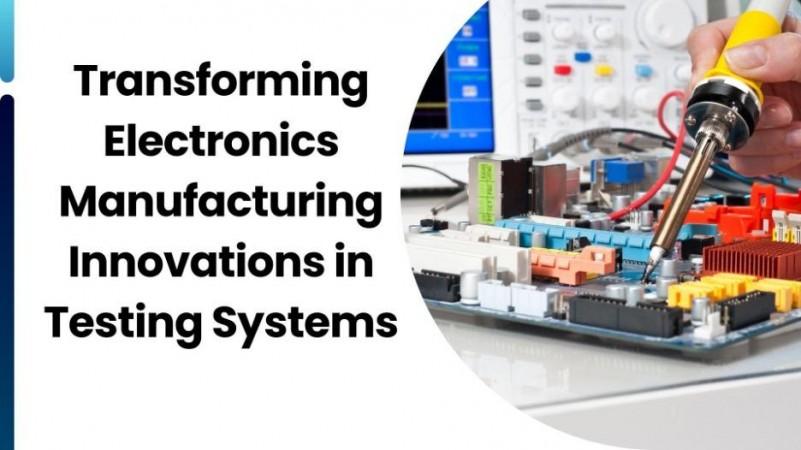
In this modern era, as electronics manufacturing evolves, testing systems play a critical role in ensuring product quality, reliability, and efficiency. Gautam Nandkishore Nayak, a professional in advanced manufacturing methodologies, explores the transformative impact of modern testing systems on electronics production.
The Growing Importance of Manufacturing Testing
Manufacturing testing has advanced from manual inspections to automated and AI-driven systems, tackling the complexity of modern electronics. With devices like smartphones containing over 1,500 components, testing systems are indispensable for maintaining quality. Studies show defect detection rates exceeding 98.5%, with AI reducing false positives to 3.2%. These innovations enhance reliability, cutting warranty claims by 42.3% and reducing field failure rates by 76.8%.
Core Testing Methodologies
Design Validation Testing (DVT)
DVT ensures designs meet functional and performance specifications. Advanced approaches reduce validation time by 45%, achieving fault detection efficiency of 87% while minimizing testing cycles by an average of 3.2 iterations.
In-Circuit Testing (ICT)
ICT systems achieve coverage rates of 92% for analog components and 95% for digital circuits. These systems incorporate boundary scan testing, achieving defect detection rates of 98%. Real-time impedance analysis ensures efficiency in PCB assemblies.
Functional Testing (FT)
Functional testing ensures systems perform as intended under operating conditions. Automated FT processes reduce test development time by 60% and achieve diagnostic accuracy of 96.8%. Model-based techniques improve fault coverage, cutting verification time by 40%.
Environmental Stress Testing
Environmental testing simulates extreme conditions to ensure durability. Modern chambers maintain temperature stability within ±0.3°C and support testing cycles between -40°C and +85°C. Multi-axis vibration systems simulate stresses with acceleration levels up to 10G RMS.
Advanced Inspection Technologies
Automated Optical Inspection (AOI)
AOI systems use deep learning algorithms to detect defects with 98.7% accuracy in high-density PCB inspections. Convolutional neural networks (CNNs) process up to 150,000 components per hour, reducing false positives to 2.3%. These systems classify solder joint defects with 96.8% accuracy.
X-Ray Inspection
X-ray inspection systems, enhanced with AI, detect voids as small as 2μm in solder joints with 97.3% accuracy. Their spatial resolution of 5μm and 65% improved throughput make them effective for inspecting multi-layer PCBs.
AI and Digital Twins in Testing
AI and digital twin technologies reshape manufacturing testing by enabling real-time monitoring and predictive insights. AI-driven analytics detect faults up to 37 hours in advance, reducing unplanned downtime by 41.2%. Digital twins synchronize physical assets with virtual models, improving first-time-right production rates by 41% and cutting product development time by 38%.
Edge Computing in Testing Systems
Edge computing improves the speed and efficiency of testing processes. These systems process data with latencies below 5 milliseconds, enhancing real-time decision-making by 58%. Handling data streams of up to 850 MB/s, edge solutions reduce defect escape rates by 76% and minimize cycle times by 47%.
Addressing Integration Challenges
Integrating modern testing systems with legacy infrastructure presents challenges, particularly in maintaining operational continuity. Unified data formats and middleware solutions resolve interoperability issues, improving integration efficiency by 56%. Additionally, AI-driven optimization reduces test execution times by 42% while maintaining defect detection rates above 99.2%.
The Future of Electronics Manufacturing Testing
Future advancements will focus on deeper integration of AI, digital twins, and edge computing. AI will improve anomaly detection and testing sequence optimization, while digital twins enhance process insights. Blockchain technologies may also ensure data integrity and traceability across supply chains.
In conclusion, Gautam Nandkishore Nayak emphasizes the transformative role of advanced testing systems in electronics manufacturing. By leveraging innovations like AI, digital twins, and edge computing, manufacturers can achieve improved product quality, efficiency, and scalability. These technologies will redefine how manufacturers address challenges in an increasingly competitive industry.








![Sky is the limit: IndiGo is now tenth largest airline by capacity globally; growth indisputable [details]](https://data1.ibtimes.co.in/en/full/767455/sky-limit-indigo-now-tenth-largest-airline-by-capacity-globally-growth-indisputable-details.jpg?w=220&h=138)








